Pictorial Meanderings
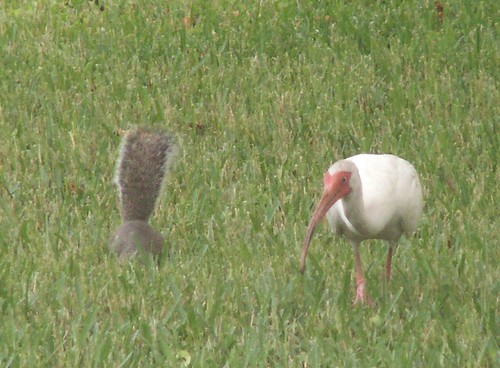
Large view
This white ibis and Eastern gray squirrel were keeping company in a neighbor's yard: one of various sights captured in local travels....
Eudocimus albus, Family Threskiornithidae. Says eNature.com, "Around their colonies, ibises eat crabs and crayfish, which in turn devour quantities of fish eggs. By keeping down the numbers of crayfish, the birds help increase fish populations. In addition, their droppings fertilize the water, greatly increasing the growth of plankton, the basic food of all marsh life. White Ibises gather at dusk in spectacular roosts, long lines of birds streaming in from all directions." Down here they also hang out in people's yards, digging in the grass for food.
The Eastern gray squirrel (Sciurus carolinensis, Family Sciuridae) is by far the most abundant of Florida's three tree squirrel species. (The other two are the fox and flying squirrel.)
"Here in Florida, squirrels usually produce 2 litters of 2-4 young each year," according to the University of Florida. "The first litter is born in January or February while the second arrives in mid-summer. Young squirrels mature rather slowly for a rodent and are on their own in about 2 1/2 months."
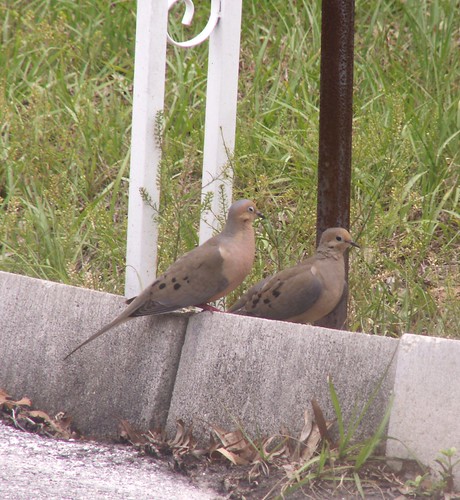
Large view
This pair of Mourning Doves sat at the edge of my yard as I arrived home from my walk. Zenaida macroura, Family Columbidae. This species is among the 10 most abundant birds in the United States, according to the Cornell Lab of Ornithology.
The dragonflies have returned to our "post office pond."
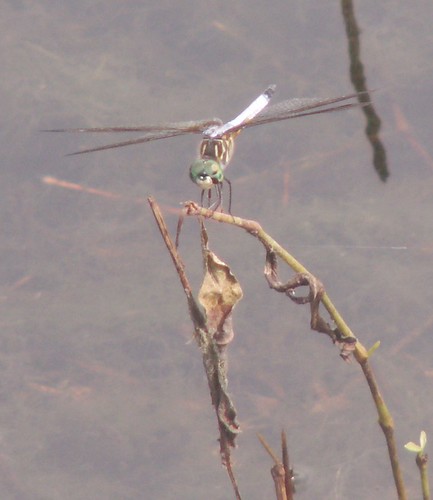
Large view.
Male Blue Dasher, Pachydiplax longipennis, Family Libellulidae (Common Skimmers). According to Bugguide.Net, these dragonflies range across "much of the United States, and just edging into Canada. In the United States, absent from the Dakotas and the Rocky Mountain region. Range continues into Mexico."
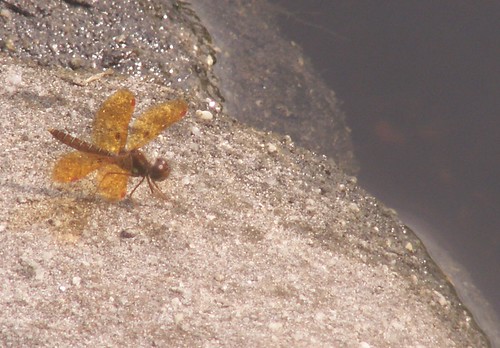
Large view.
Male Eastern Amberwing, Perithemis tenera, Family Libellulidae (Common Skimmers). According to Bugguide.Net, "Except along the U.S.-Mexican border, this is the only tiny dragonfly with amber wings on the male." By tiny they mean about a one-inch wingspan. The range of this dragonfly is the eastern two-thirds of the United States and south into Mexico. "Primarily a summer species; active all year in the far southern U.S."
Our strip malls (the two I most frequent are what I call the "post office strip mall" and the "supermarket strip mall") have been abounding with wildlife:

Large view
Thanks to Jeff Hollenbeck at Bugguide for identifying this as Plexippus paykulli, Pan-tropical Jumper. This is the only species of the Plexippus genus in the U.S., and one of two jumping spiders (Salticidae) in Florida that have been imported by humans from the Old World. "Both are almost exclusively associated with man-made structures, usually buildings where they may be numerous around lights at night, catching the insects attracted to the lights," according to the University of Florida.
I have a photo of the other Old World import, the gray wall jumping spider (Menemerus bivittatus), here.

Large view
I spotted this katydid perched above eye level and decided to engage it in a staring contest.

Large view
I'm guessing that this is a Squirrel Treefrog, but I'm not entirely certain. After a while it got a little camera shy and hopped onto the mulch at bottom right.
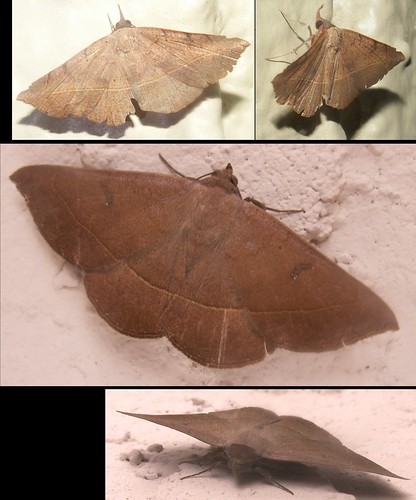
Large view
Curved-tooth Geometer Moth, Eutrapela clemataria, Family Geometridae (Geometrid Moths). Before now, the only other member of this species I'd seen had been a dead one, so I was happy to discover two living individuals. I took the top two photos with flash on the evening of June 10. This male, a bit worse for wear, was on the wall of the "post office strip mall." I found the more robust male perched at the "supermarket strip mall" two days later.
According to Bugguide.Net, clemataria is the only species in this genus in North America listed at All-Leps. I used this guide at Dalton State College to determine the gender.
And the bunnies are back.
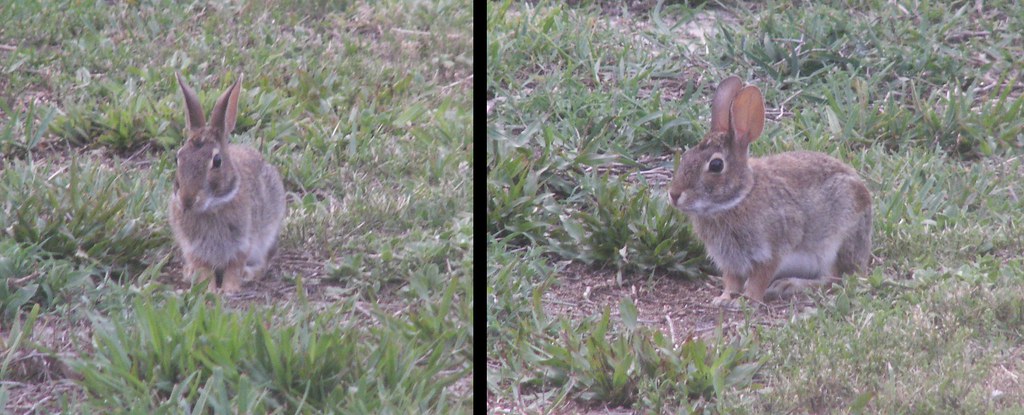
Large view
This one was enjoying a neighbor's yard around dusk. Eastern Cottontail, Sylvilagus floridanus, Family Leporidae (Hares and Rabbits). One of two species of rabbit in Florida (the Marsh Rabbit is the other), the Eastern Cottontail also "has the widest distribution of any Sylvilagus. It is found from southern Manitoba and Quebec to Central and northwestern South America. In the contiguous United States, the eastern cottontail ranges from the east to the Great Plains in the west." (University of Michigan Museum of Zoology.) Grass accounts for about 50 percent of its diet.
Early afternoon afforded this glimpse of a male Eastern bluebird:
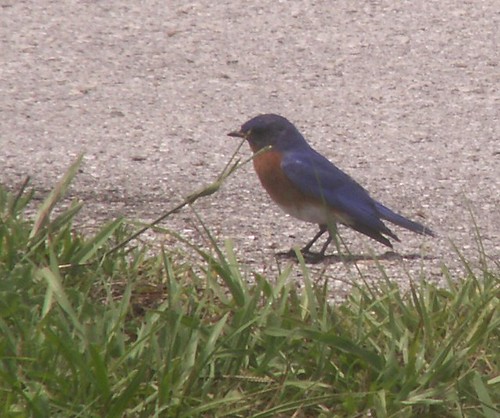
Sialia sialis, Family Turdidae. Writes John Ivanko in Michigan Today (Fall 1999):
"The bluebirds' color was so remarkable to Henry David Thoreau that he felt compelled to describe this species' coloring as 'carrying the sky on its back.' An insightful description since the bluebird's blue color does, in fact, come from light waves scattered by the structure of their feathers, not from blue pigment in their feathers-a blue suncatcher, so to speak. That's why a bluebird appears gray on an overcast day."
Adds the Cornell Lab of Ornithology, "Populations declined in 1960s and 1970s, but increased thereafter. Increased popularity of nest box campaigns probably responsible for increases. Vulnerable to competition from introduced nest-hole competitors, such as European Starlings and House Sparrows. Common and increasing in eastern North America."
And just because I thought this looked rather cool...

Large view
Someone's beautiful kite has gotten stuck in a palm tree.
Our theater has been busy doing double duty, serving as the art center's meeting place during renovations and preparing for our summer feature, The Music Man.
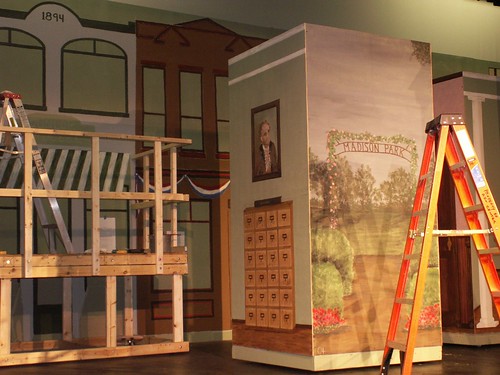
The 200-seat theater is not built to handle flies (which I recently learned are painted scene curtains that are raised and lowered, requiring a very high ceiling), so the stage designers came up with an ingenious system of four-sided components that can be separated, rotated, and pushed back together. Having to use the theater for my free-writing meetings means I'm getting to see behind-the-scenes preparations for the first time. Had I more time after our last meeting, I'd have taken shots of an almost-completed painting job, plus rooms filled with costumes being put together.

I also learned that our art center's roses are insulation-colored:

I found the rose and insulation positioned as is and liked the juxtaposition. The rose grows outside the rear entrance to our building under renovation:

Who needs "Snakes on a Plane" when you've got this?

I like this photo because I finally found a room that's messier than mine. This is the site of our main gallery. Compare with this photo from March 15.
The art center's been posting my photos on a rotating basis week to week on its website.
In other news, I've gone over the edits from Koboca for Covenant and am working on a couple of writing assignments. I also received the great news last week that my story "Hermit Crabs" has been accepted to Electric Velocipede.











0 Comments:
Post a Comment
<< Home